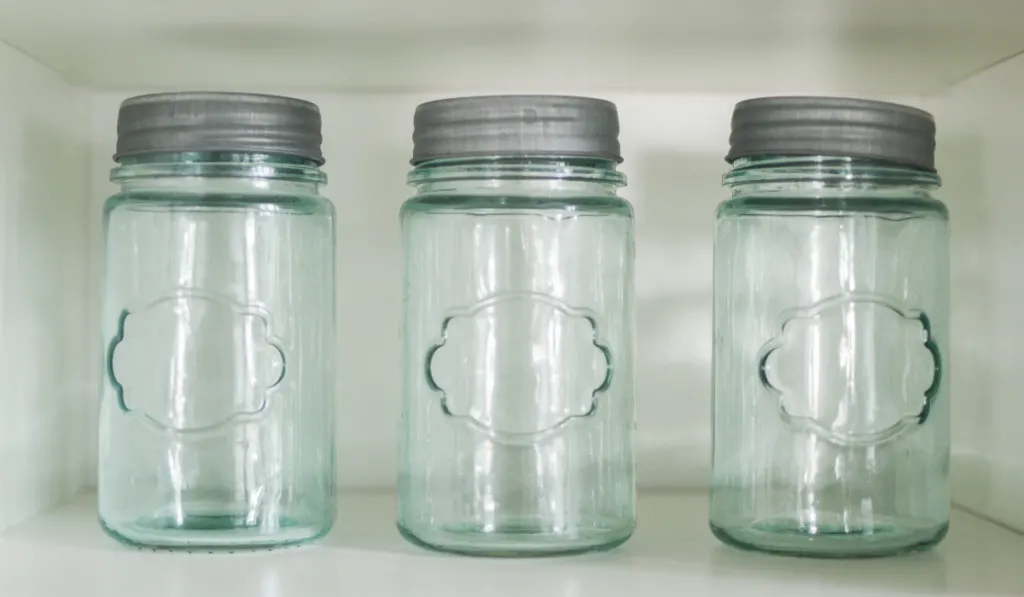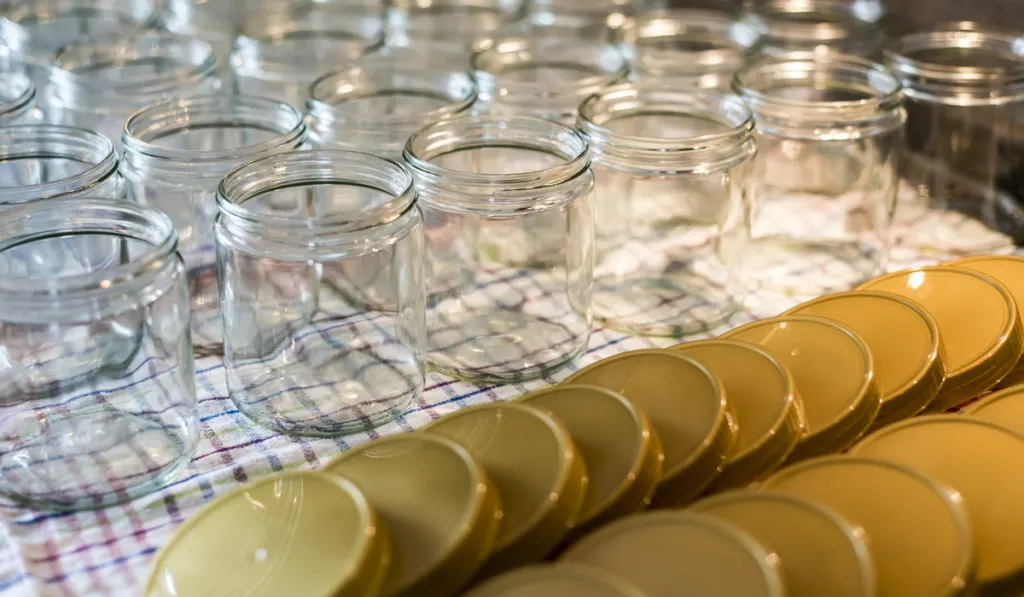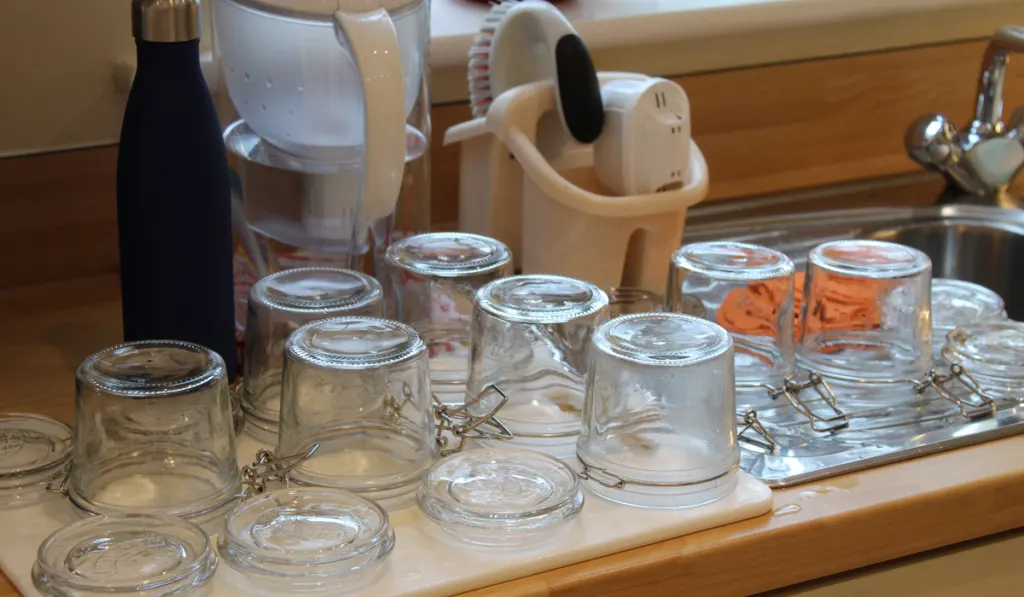Mason jars have many uses but are generally used for food canning purposes. To preserve your surplus foods or even to store your home-made preserves, pickles and jams require a sturdy jar to keep your food bacteria-free, tasty, and safe to eat at a later stage.
You can sterilize mason jars for preserving your food by boiling them first, but don’t boil the lids as the rubber sealing bands will perish, allowing air into the jars and contaminating the contents. The best way to preserve, store and keep your food to eat later is to use a boiled mason jar.
Canning is a process used by homesteaders, preppers, survivalists, and generally anyone who has surplus produce or has bought food in bulk for home canning and storage purposes.
All containers that are used for canning purposes need to be thoroughly cleaned and sterilized before they can be safely filled with your produce. Let’s find out more about boiling mason jars.

Table of Contents
Can Mason Jars And Lids Be Boiled?
As mason jars are made from bleached glass, it is easy to see inside the jar and to keep track of what the contents are.
This ability to regularly check to see if the contents are still fresh or have been contaminated by bacteria makes the mason jar an ideal container for canning and storage.
The mason jar is extremely popular amongst the canning community because of its ability to store and preserve many kinds of food for a very long time.
To prevent contamination and bacteria from destroying your preserved food, all mason jars used for storage and canning purposes must be sterilized before use.
There are many methods available to sterilize mason jars and lids, but the easiest method by far is the boiling method, as you do not need to buy any fancy equipment if you don’t want to. Standard kitchen tools should be enough for this method.
The most important feature of the mason jar is the lid, since it has a rubber ring on the underside, which creates an air-tight vacuum seal and an outer band with screw threads for tightening the lid.
The outer bands are re-usable and can be used many times, but the lids can only be used once to seal a jar.
As stated earlier in this post, do not boil the lids. Rather follow the below instructions on how to clean the lids before use.

How To Boil Mason Jars And Lids
Sterilizing a mason jar by using the boiling method is not difficult as long as you follow some basic procedures and use the correct equipment.
What Equipment Do I Need To Boil A Mason Jar And Lid?
You do not need to go out and buy any special equipment to use for boiling mason jars and lids, as you should already have everything that you need in your kitchen:
- A large deep pot with a lid and a rack
- A wooden spoon, a ladle, and a paring knife
- A jar lifter or lifting tongs
- A home canning funnel – plastic will do
- Rubber spatula for removing air bubbles
How To Sterilize A Mason Jar And Lid In Boiling Water
Make sure that the mason jar is empty before boiling it and that the lid is removed!
- Check the mason jars first for any cracks or nicks in the glass. Do not use them for preserving food if they are damaged in any way. Always make sure that you use new lids when preserving foods, but the bands can be reused.
- Wash the mason jars and lids first in soapy water and leave to dry on a clean kitchen towel.
- Pack the mason jars and lids into the pot of your choosing. Don’t pack more than four mason jars at a time into the pot.
- Cover the mason jars in the pan with water and allow the water to boil rapidly.
- The water needs to simmer for at least 10 minutes before removing the lids.
- Use the Jar lifter to remove the lids from the water and place them on a clean, dry kitchen towel.
- Leave the mason jars in the simmering water until you are ready to use them. This reduces the risk of contaminating your food. The mason jars should be in boiling water for at least fifteen minutes to completely sterilize them.
- Remove the jars one by one using the jar lifter and fill while still hot to prevent the glass from breaking. Use the rubber spatula to smooth down the top of the food and to remove the air bubbles before sealing.
- Remember to only place hot food into hot mason jars. Cold food into a hot jar will cause the glass to crack or shatter.
Top Tip: Prepare the food which you are going to preserve before boiling and sterilizing the mason jars. This way, as soon as the mason jars are sterile, the food can be placed directly into them with a reduced risk of contaminating the food.

Will A Mason Jar Shatter In Boiling Water?
When using glass jars or containers to store any kind of food for preserving, be aware of a condition called thermal shock.
Thermal shock is a term used to describe a sudden change in temperatures and the effects that this change can have on certain materials.
In this case, if you pour hot liquids into a cold mason jar, it could shatter or crack. Or, if you put a cold mason jar into boiling water, it could have the same effect.
To sterilize a mason jar, you would first place the jar into a pot of cold water and heat it up, thereby reducing the effect of thermal shock as the glass temperature increases along with the water temperature.
If you place a cold jar directly into boiling water, the chances are that it will shatter. This is why all the recipe instructions when adding food to a sterilized mason jar explain the dangers of adding hot foods to cold jars and advise against it.

Alternative Ways To Sterilize A Mason Jar
Other than the boiling method, there many acceptable ways to sterilize mason jars and lids for food preservation and storage. Make sure to research which way would best suit your needs according to the time that you have available and the equipment that you have in your kitchen.
Other acceptable methods of sterilizing mason jars are:
- Steaming the mason jars in a pressure cooker. Suitable for both jars and lids – remove the lids after ten minutes of simmering in the pot. Switch off the heat and leave the mason jars covered in the pot until ready to be filled with food.
- Placing the jars in a microwave oven for one minute per mason jar – do not place lids in the microwave as this could cause arching and damage the machine! Leave the sterile mason jars in the microwave with the door closed until ready for use.
- Place the mason jars and the lids in the dishwasher and rinse on the highest temperature setting. Keep the door closed to keep the mason jars clean and sterile until ready to use.
- Lay the clean mason jars on a rack in the oven and turn up the heat to 275 degrees Fahrenheit (135 degrees Celsius). Leave the jars in the oven for at least twenty minutes to sterilize and only remove once ready to be used. Do not place the lids into the oven to sterilize as the rubber seals will melt. Rather use one of the other sterilizing methods for the lids.
Conclusion
Mason jars are wonderful containers and are used by many people for storing many different items. They may not always need to be sterilized before being used unless they are used for storing and preserving food, but they do always need to be cleaned correctly before use.
Boiling the jars and lids is an effective way to sterilize these items, but the correct procedures should always be followed to minimize any food contamination. Once the food is stored correctly, it can be consumed up to twelve months later, making this method of sterilizing an easy, effective way to clean any mason jar.
Resources
- http://www.mamashomestead.com/preparing-jars-and-lids-for-canning/
- https://www.huffpost.com/entry/all-about-mason-jars_n_55fc11dbe4b00310edf6a2a7
- https://expandusceramics.com/qa/can-you-pour-boiling-water-into-mason-jar.html
- https://www.freshpreserving.com/blog?cid=water-bath-canning
